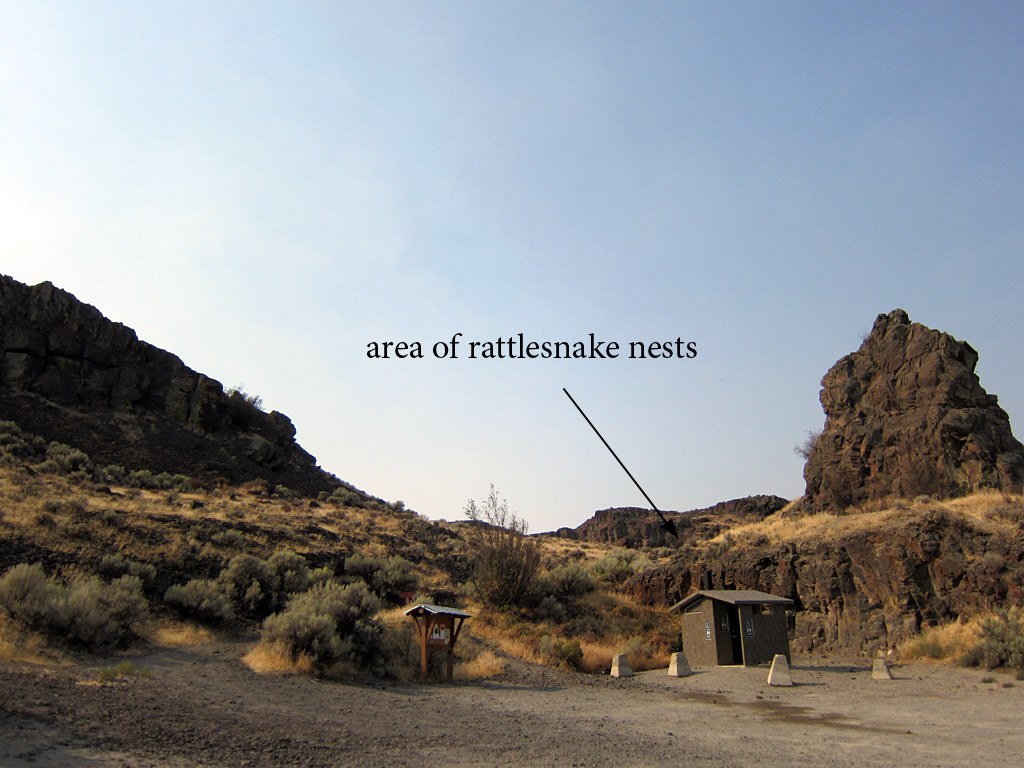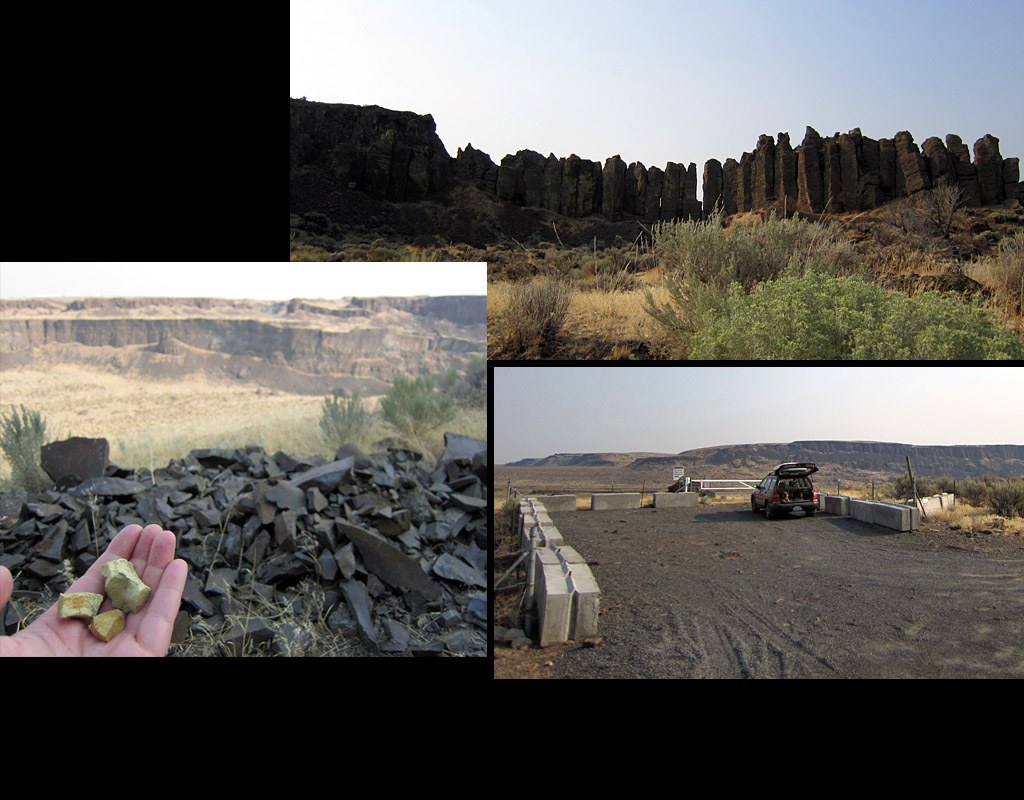
There's a reason no one seems to hike here in the summer. First there's the part about it being inhumanely hot by 8:30am, and then there are the rattlesnakes.
We'd come down the night before to catch the Perseids in those clear, eastern Washington skies, intending to camp at Echo Basin just up the road from the trailhead here and then explore this hike in the morning. But last minute we diverted to the Sand Hollow campground south of the bridge where there is camping right along the river/lake (this section of the Columbia is more like a lake between the Wanapum and Rock Island dams). Just after sunset, walking back to the car from our camp spot, the dogs both suddenly jumped, and I heard an unmistakable rattle. Before the dogs could get curious, I gave them a "Leave It" so loud they jumped back a second time. The small snake was just to the side of the path (by some picnic tables!), coiled into the size of a softball and rattling for all it was worth, seemingly as frightened as we'd been. I looked the dogs over carefully and am genuinely grateful to that snake for not taking it beyond rattling. No more trips to the car at dusk, and our enthusiasm for hiking in the dessert was dampened, but the meteors were awesome!
The next morning, we drove over for a look at the Frenchman Coulee area. Still spooked by the rattlesnake run-in, I opted against the hike with two dogs but always appreciate a look at the 14-15 million year old basalt lava formations which are among the biggest in the world. Not surprisingly, the waterfall is looking sparse.
While chatting with a ranger and relaying the rattlesnake encounter, he said that this has been a bad year for them and that the park rangers had just met about several nests that were recently discovered in one of the camping spots at Echo Basin. Nothing is posted yet, but it's one of the better positioned spots where we've camped in previous years, up the hill from the other road-side areas, well above the bathrooms and behind the big rock formation, so more secluded than the rest of the campground. This year, less optimal -- heads-up.
And now my continuing education on helping the dog Survive The Hazards of Nature includes rattlesnakes. While encounters, never mind bites, are rare, it's good to know stuff, and maybe some of you will find this useful. A lot of the commonly held snake-bite treatments are no longer recommended and are either of no benefit or actually harmful. So, if a human or dog is bit, do NOT: tie a tourniquet (it is more likely to lead to an amputation), try to suck out the venom (not effective), mess with any of the snake bite kits (they are mostly about trying to suction out venom which is not considered effective), lance the bite in any way (only increases odds of infection), nor try to catch the snake for identification (seriously). What is currently recommended is to keep the person or dog as still as possible and ideally have them carried back to the car. Keep the bite below their heart, flush it with clean water and apply an antibacterial. It's a great idea to carry Benadryl in your first-aid kit anyway, and here it's the primary recommended first-aid: normal adult dose for humans, and a dose of 2mg/lb for dogs (this is specific for venomous snake bites and double the normal dose for dogs of 1mg/lb but still safe. For dogs, this may be the most critical part of the treatment and potentially life-saving. To be safe for dogs, you want to carry only the one-ingredient Benadryl, no additives. Any generic is fine as long as there's only the one ingredient: Diphenhydramine.) If the bite is on a limb, wrap a light compression bandage above the bite -- again, not a tourniquet, but loose enough to easily slip a finger under. The idea is to just slow the progression of the venom. Evidently snake bites hurt like a sonofabitch, so if you don't already anyway, you might consider carrying aspirin for your dog and something stronger for humans. (Never give dogs tylenol, advil, or any of the generic equivalents. Only aspirin or a canine-specific pain killer. Same as for the human variety, I save a few pain-killers from prescription events to keep in my first-aid kit. Especially good is Tramadol which is an opiate safe for both dogs and humans.) And get them to a hospital/vet as soon as possible. I had the numbers of emergency vets in Ellensburg and Yakima on my phone and am grateful to have not needed them.
This is an amazing area and well worth exploring, just maybe not with dogs in the middle of summer. Another time! Some pretty good imagery and info on the local geology to be had here: https://www.youtube.com/watch?v=ssy_UDPAOZ8






Comments
Outstanding Report/Geology
Thank you so much for the advice on how to handle a rattlesnake bite. That was incredibly useful.
The geology of eastern WA is truly a spectacular story. Below is a link for the best concise video that I've seen. It gives a quick summary of the events. There is a lot more to this story but this is a good place to start.
https://www.youtube.com/watch?v=r_u-4pT8TuY
The Dry Falls Visitors center near Sun Lakes is a great place to get information. They have a movie that highlights the geologist who first proposed the theory of the Ice Age Floods. He was rejected by the geology community for decades for his outlandish theory. Geological evidence eventually validated his theories and he was eventually celebrated as a genius.
Posted by:
Maddy on Aug 15, 2015 09:29 AM
Good stuff
Thanks, Maddy, that video is great as well. Lava bursting from the ground 15 million years ago, ice and floods 15 thousand years ago; that's a big pile of drama for one little canyon. Can you imagine if any of that happened in the age of CNN? It would be a Climate Apocalypse.
I hope the guy who theorized about the ice age floods got to live to see his ideas validated. You'd think scientists would learn from all the other times (flat planet, sun orbiting us, etc.) and not be such asshats about new ideas. But I suppose it's sometimes a fine gradiation from crazy to brilliant.
For anyone who wants the full-on details, there's also this hour-long lecture from Central WA U on the geology of this area. Free college and a whole lot of Nature Drama:
https://www.youtube.com/watch?v=ZgVmW_OAB0s
Posted by:
Girl and Dog on Aug 15, 2015 01:12 PM
Geologist Bretz
Harlen Bretz is the geologist who came up with the theory of Ice Age Floods creating the features seen in Eastern WA. Back in the 1920's he found unusual erosion features such as huge box shaped dry canyons (coulees), enormous dry waterfalls and big round potholes that he concluded could have only be caused by a massive flow of water. It wasn't until giant ripple marks that were 50 feet high and 500 ft apart were discovered that he was finally vindicated in the 1950's. Satellite images from the 1970 clearly showed the effects of the massive floods and solidified the theory. Bretz lived until 1982 so fortunately he was around to bask in the glory of his fame.
Posted by:
Maddy on Aug 16, 2015 02:52 PM
Nice!
That right there is a good story with a happy ending. Thanks Maddy (or Maddy's human... I won't presume to know which one is typing and/or the geology scholar.)
Posted by:
Girl and Dog on Aug 17, 2015 02:56 PM
Fantastic trip report
Great details and also hilarious. I'm thinking of entitling our next blog about dogs as: 'Helping the Dog Survive The Hazards of Nature'. Thanks, Girl and Dog. Also, huzzah for stars and geology.
Posted by:
Loren Drummond on Aug 17, 2015 10:49 AM
Yay for dogs, stars and rocks
Ha, thanks, Loren, and whatever I can do for the dogs of the WTA, I feel good about.
Posted by:
Girl and Dog on Aug 17, 2015 02:58 PM